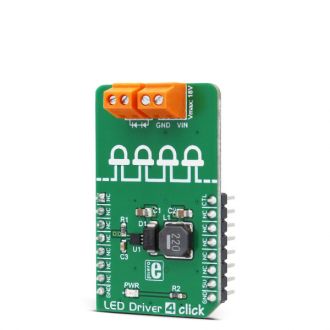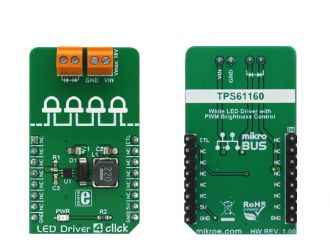
We strongly encourage users to use Package manager for sharing their code on Libstock website, because it boosts your efficiency and leaves the end user with no room for error. [more info]

Rating:
Author: MIKROE
Last Updated: 2018-06-01
Package Version: 1.0.0.0
mikroSDK Library: 1.0.0.0
Category: LED Drivers
Downloaded: 3893 times
Not followed.
License: MIT license
LED Driver 4 click is a form of a high-efficiency boost converter that is ideally suited for driving an array of white LEDs. The driver has the ability to dim the connected LED array, without producing any noise on the output.
Do you want to subscribe in order to receive notifications regarding "LED Driver 4 click" changes.
Do you want to unsubscribe in order to stop receiving notifications regarding "LED Driver 4 click" changes.
Do you want to report abuse regarding "LED Driver 4 click".


Library Description
The library carries functions necessary to have complete control over all functionalities of the Click board.
Examples Description
The demo application is composed of three sections:
void applicationTask()
{
dutyCycle += 50;
PWM_TIM5_Set_Duty(dutyCycle, _PWM_NON_INVERTED, _PWM_CHANNEL1);
if (dutyCycle > pwmPeriod )
dutyCycle = 0;
Delay_ms(2);
}
Other mikroE Libraries used in the example:
Additional notes and information
Depending on the development board you are using, you may need USB UART click, USB UART 2 click or RS232 click to connect to your PC, for development systems with no UART to USB interface available on the board. The terminal available in all MikroElektronika compilers, or any other terminal application of your choice, can be used to read the message.